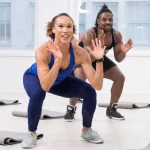Yoga Exercises For Weight Loss
You should try these yoga exercises for weight loss. Losing weight through yoga requires dedication and consistent practice. Engaging in more physically demanding styles of yoga tends to burn the most calories and can also help prevent weight gain over time.
Yoga is not just about physical exercise; it promotes overall physical, mental, and spiritual growth, enabling you to cultivate the best version of yourself. This holistic approach can enhance your well-being and contribute to your weight loss journey.
Active forms of yoga can be particularly effective for weight loss, as they provide a workout that increases calorie expenditure. Additionally, even gentler, more relaxing yoga practices can foster greater awareness and mindfulness, which may lead to healthier lifestyle choices and weight loss.
Many experts believe that yoga can facilitate weight management in several ways. Let’s explore a few of these methods in more detail.
Yoga and Mindfulness
The mental and spiritual dimensions of yoga emphasize the development of mindfulness, which enhances your awareness on multiple levels. This increased awareness can help you become more conscious of how various foods affect your mind, body, and spirit.
Research from 2016 indicated that individuals who cultivate mindfulness through yoga may find it easier to resist unhealthy foods and avoid comfort eating. They often become more attuned to their bodies, allowing them to recognize when they are full.
Yoga can be particularly beneficial for those who face challenges in losing weight through other methods. A study conducted in 2017 showed that mindfulness training can have positive short-term effects on impulsive or binge eating and can encourage physical activity.
Although the study did not report significant direct effects on weight loss, it is believed that longer periods of mindfulness training could be associated with weight loss over time. Further research is necessary to explore these findings in greater depth.
Additionally, since it’s generally advised not to practice yoga on a full stomach, you are likely to make healthier food choices before your yoga sessions. After practicing yoga, you may find yourself craving fresh, unprocessed foods. You may also develop a habit of chewing each bite more thoroughly and eating more slowly, which can contribute to reduced overall food intake.
Yoga and Better Sleep
Practicing yoga can significantly enhance the quality of your sleep. With a consistent yoga routine, you may find it easier to fall asleep and enjoy deeper, more restorative sleep. Ideally, adults should aim for 6 to 9 hours of sleep each night for optimal health.
Quality sleep is closely linked to weight loss. A study conducted in 2018 revealed that individuals who experienced restricted sleep five times a week lost less fat compared to those who maintained their regular sleeping patterns.
Both groups limited their calorie intake, indicating that lack of sleep negatively affects body composition and fat loss.
Yoga nidra, a type of guided relaxation, can further enhance your sleep quality and promote mindfulness. This practice allows you to set intentions, which may help you establish and achieve your weight loss goals.
A small study in 2018 focused on healthcare workers who practiced yoga nidra for eight weeks. The results showed an increase in their levels of mindfulness, which included acting with awareness and avoiding judgment of their inner experiences.
Although there were no significant changes in sleepiness at the follow-up, participants who engaged in yoga nidra for a longer duration reported improvements in their sleep quality.
However, more extensive and comprehensive studies are needed to build on these findings and further explore the relationship between yoga, mindfulness, and sleep quality.
Yoga and Calorie Burning
Although yoga is not typically categorized as an aerobic exercise, some styles are more physically demanding than others. Active and intense forms of yoga can help you burn more calories, which may aid in preventing weight gain. Examples of these more vigorous types include Ashtanga, vinyasa, and power yoga.
Vinyasa and power yoga are often practiced in hot yoga studios, where the continuous movement helps increase calorie expenditure. Engaging in these dynamic forms of yoga can also contribute to muscle toning and improved metabolism.
Even though restorative yoga is not particularly intense, it can still be beneficial for weight loss. A study found that restorative yoga effectively helped overweight women lose weight, including reducing abdominal fat. This is particularly encouraging for individuals who may find it challenging to participate in more vigorous yoga styles due to their body weight.
Yoga can serve as a valuable tool for promoting behavioral change, aiding in weight loss, and supporting weight maintenance. By burning calories, increasing mindfulness, and reducing stress, yoga can help you become more aware of your eating habits and the effects of overeating.
However, more comprehensive studies are needed to further explore and confirm these findings.
How Often Should You Practice Yoga to Lose Weight?
To effectively lose weight through yoga, aim to practice as often as possible. Engaging in more active and intense yoga sessions at least 3 to 5 times per week for a minimum of 1 hour can be beneficial.
On the days you don’t do intense yoga, balance your routine with gentler classes such as Hatha, yin, or restorative yoga. These sessions can help you recover and maintain flexibility while still contributing to your overall wellness.
If you’re just starting out, it’s important to ease into your practice. Begin with shorter sessions—around 20 minutes—and gradually increase the duration as you build strength and flexibility. This approach helps prevent injuries and makes it easier to develop a consistent practice. Don’t forget to allow yourself one full rest day each week to give your body time to recover.
In addition to your yoga practice, consider incorporating other forms of exercise such as walking, cycling, or swimming to enhance cardiovascular fitness and boost your weight loss efforts.
Finally, when it comes to tracking your weight, avoid weighing yourself immediately after a yoga class, particularly after a hot yoga session. This is because you may lose water weight during the class. Instead, try to weigh yourself at the same time each day for a more accurate measure of your progress.
Yoga Poses to Do at Home
If you’re short on time and can’t commit to a full yoga session, here are a few effective poses you can easily practice at home:
- Sun Salutations
Perform at least 10 rounds of Sun Salutations. You can increase the intensity by holding some poses for longer or by speeding up the flow. Here’s a step-by-step guide:
- Start Standing: Inhale as you lift your arms overhead.
- Forward Bend: Exhale and swan dive down into a Forward Bend.
- Plank Pose: Jump, step, or walk your feet back into Plank pose. Hold this position for at least five breaths.
- Lower Down: Drop your knees, then lower your body to the floor.
- Cobra Pose: Extend your legs, turn the tops of your feet to the mat, and place your hands under your shoulders. Inhale to lift partway, halfway, or all the way into Cobra pose.
- Downward Facing Dog: Exhale to lower back down and then push up into Downward Facing Dog. Hold for at least five breaths.
- Forward Bend: Exhale as you jump, step, or walk your feet to the front of the mat into a Forward Bend.
- Return to Standing: Inhale to lift your arms overhead again. Exhale to lower your arms back down by your sides.
- Boat Pose
This pose engages your entire body, especially your core, while also helping to reduce stress. Here’s how to do it:
- Sit on the Floor: Begin by sitting with your legs together and extended in front of you.
- Lift Your Feet: Bend your knees and lift your feet off the floor so your thighs form an angle with the floor and your shins are parallel to the floor.
- Extend Your Arms: Reach your arms forward so they are parallel to the ground.
- Straighten Your Legs (if possible): If you can, straighten your legs while keeping your torso lifted.
- Hold the Pose: Maintain this position for 30 seconds.
- Repeat: Aim to repeat the pose at least five times.
These poses are great for incorporating yoga into your daily routine, even when you’re pressed for time!
Plank Pose
Incorporating plank variations into your routine for 10 to 20 minutes can be very beneficial for building strength and stability. Here’s how to perform the basic plank pose and some variations:
Basic Plank Pose
- Start in Tabletop Position: Begin on your hands and knees with your wrists aligned under your shoulders and your knees under your hips.
- Step Back: Step your feet back, lifting your heels off the ground. Your body should form a straight line from your head to your heels.
- Check Your Alignment: If possible, check your position in a mirror to ensure your body is aligned correctly.
- Engage Your Muscles: Activate your core, arm, and leg muscles to maintain stability.
- Hold the Position: Aim to hold this basic plank for at least one minute.
Plank Variations
To keep your practice interesting and challenge different muscle groups, you can incorporate these variations:
- Forearm Plank: Lower down onto your forearms with elbows directly under your shoulders, keeping your body in a straight line.
- Side Plank: Rotate your body to one side, stacking your feet and lifting one arm toward the ceiling. Hold this position and then switch sides.
- Plank with Shoulder Taps: While in plank position, lift one hand to tap the opposite shoulder, alternating sides. Keep your hips steady.
- Plank to Downward Facing Dog: From plank position, push back into Downward Facing Dog, and then return to plank. Repeat several times.
- Plank with Leg Lifts: While in plank, lift one leg off the ground, hold for a moment, and then lower it back down. Alternate legs.
These variations can help you strengthen your core, arms, and legs while enhancing your overall stability and endurance. Enjoy your plank practice!
Bulimia Nervosa An Eating Disorder
Natural Treatments for the Brain
Cucumber Beautifies and Cleanses the Skin
Turmeric for your stomach and skin

A graduate of Computer Science and Information Management Technology. Diploma – Caregiving, Certificates – Dementia and Diabetes Awareness and Management. A researcher, blogger, songwriter, singer and acoustic guitarist. Born in an environment where natural talents such as healing are imparted at our natural birth. This natural talents of healing is the result of our genetic inheritance and the training from family environment.














